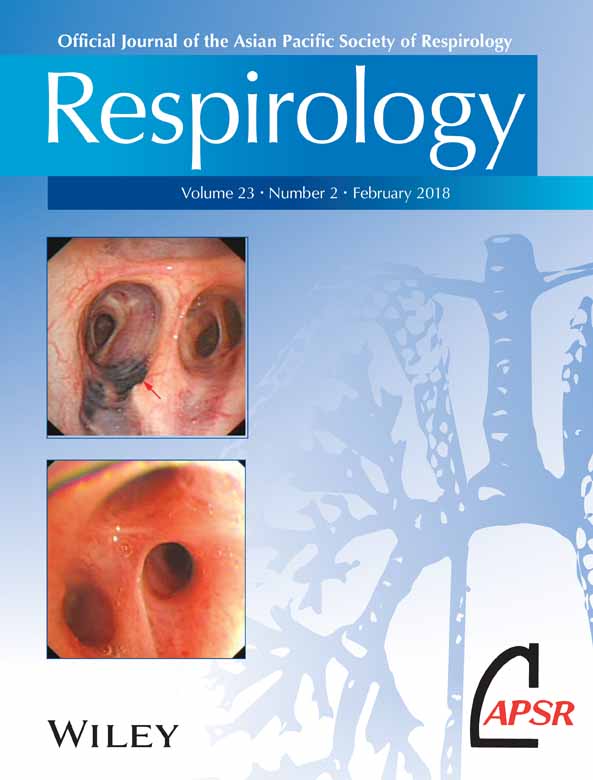Impact of gastric reflux on asthma in clinical practice
Porsbjerg and Menzies-Gow reviewed the clinical impact of co-morbidities on severe asthma management.1 The European Respiratory Society/American Thoracic Society (ERS/ATS) guidelines on severe asthma and the Global Initiative for Asthma (GINA) document recommend a systematic assessment of potential co-morbidities in all patients with possible severe asthma.2, 3 Co-morbidities may significantly affect asthma control, both aggravating and mimicking symptoms. Thus, recognition of a co-morbidity is a crucial step in the workup of severe asthma.
Gastric reflux (GR) is quite common in asthmatic patients, mainly in patients with severe asthma. Although this issue has been recently investigated Porsbjerg and Menzies-Gow,1 some pathophysiological aspects remain obscure. We now present our retrospectively conducted clinical study of 188 (107 females) consecutive outpatients with asthma. The aim was to evaluate the impact of some demographic and clinical variables (body mass index (BMI), past smoking, GINA asthma control grade, sinonasal co-morbidity, respiratory symptoms in the current month, early onset of asthma, symptom perception assessed by visual analogue scale (VAS), asthma control test (ACT) and lung function (including forced vital capacity (FVC), forced expiratory volume in 1 s (FEV1), FEV1/FVC and FEF25–75 (forced expiratory flow at 25-75% of vital capacity))) on GR co-morbidity. GR was diagnosed according to evidence-based practice guidelines for gastro-oesophageal reflux disease (2015), by typical symptoms, validated questionnaire, protonic pomp inhibitor (PPI) test and gastric endoscopy.
To assess the association between GR with the considered variables, a univariate analysis was performed using the binary Firth's penalized-likelihood logistic regression. Significant covariates were selected for the multivariate analysis. The likelihood ratio (LR) test was used. Data were acquired and analysed in R v3.3.2 software environment.4
GR co-morbidity (GR+) was present in 41 (21.81%) of these outpatients. Table 1 shows the difference between GR+ and GR− subjects. GR was associated with early asthma onset and lower ACT values (P = 0.0098 and 0.0033, respectively). The multivariate analysis (Table 2) showed significant associations between GR, early asthma onset and ACT (P = 0.0197 and 0.0103, respectively).
| GR | ||||
|---|---|---|---|---|
| Study variable | No 147 (78.19%) |
Yes 41 (21.81%) |
OR (95% CI) | P-value |
| Age (years) | 53.1 (15.25) | 54.54 (14.34) | 1.01 (0.98–1.03) | 0.6003 |
| Gender | 0.0804 | |||
| Males | 66 (84.62%) | 12 (15.38%) | 1 | |
| Females | 79 (73.83%) | 28 (26.17%) | 1.91 (0.93–4.11) | |
| Past smoking | 0.9371 | |||
| No | 67 (77.91%) | 19 (22.09%) | 1 | |
| Yes | 38 (77.55%) | 11 (22.45%) | 1.03 (0.44–2.35) | |
| Sinonasal co-morbidity | 0.5548 | |||
| No | 105 (77.21%) | 31 (22.79%) | 1 | |
| Yes | 40 (81.63%) | 9 (18.37%) | 0.79 (0.33–1.72) | |
| GINA asthma control | 0.1694 | |||
| Well controlled | 50 (86.21%) | 8 (13.79%) | 1 | |
| Partially controlled | 84 (73.68%) | 30 (26.32%) | 2.14 (0.96–5.22) | |
| Uncontrolled | 10 (83.33%) | 2 (16.67%) | 1.41 (0.24–6.14) | |
| Symptom | 0.3388 | |||
| None | 30 (85.71%) | 5 (14.29%) | 1 | |
| Bronchial | 15 (65.22%) | 8 (34.78%) | 3.04 (0.9–11.05) | |
| Nasal | 55 (79.71%) | 14 (20.29%) | 1.45 (0.52–4.60) | |
| Both | 45 (77.59%) | 13 (22.41%) | 1.65 (0.57–5.29) | |
| Early onset† | 0.0098 | |||
| No | 75 (72.82%) | 28 (27.18%) | 1 | |
| Yes | 30 (93.75%) | 2 (6.25%) | 0.22 (0.04–0.72) | |
| BMI | 26.16 (6.98) | 27.86 (5.61) | 1.03 (0.99–1.08) | 0.1604 |
| ACT† | 20.88 (3.71) | 18.8 (4.27) | 0.88 (0.81–0.96) | 0.0033 |
| FVC (% predicted) | 97.32 (18.85) | 99.26 (19.57) | 1.01 (0.99–1.02) | 0.5713 |
| FEV1 (% predicted) | 80.28 (22.77) | 84.97 (21.03) | 1.01 (0.99–1.03) | 0.2405 |
| FEV1/FVC | 71.89 (15.67) | 77 (16.79) | 1.02 (0.99–1.04) | 0.0747 |
| FEF25–75 (% predicted) | 46.59 (26.92) | 53.14 (32.77) | 1.01 (0.99–1.02) | 0.2107 |
| VAS | 7.2 (2.52) | 6.91 (2.7) | 0.95 (0.74–1.24) | 0.7176 |
- † Variables entered in the multivariate analysis (see text for more details).
- ACT, asthma control test; beta, coefficient of regression; FEF25–75, forced expiratory flow at 25-75% of vital capacity; FEV1, forced expiratory volume in 1 s; FVC, forced vital capacity; GINA, Global Initiative for Asthma; GR, gastric reflux; P-value, likelihood ratio P-value; VAS, visual analogue scale.
| Characteristic | Beta | SE (Beta) | OR (95% CI) | P-value |
|---|---|---|---|---|
| Intercept | 1.53 | 1.01 | 4.64 (0.65–34.76) | 0.1272 |
| ACT | −0.13 | 0.05 | 0.88 (0.79–0.97) | 0.0103 |
| Early onset | 0.0197 | |||
| No | 0 | — | 1 | |
| Yes | −1.53 | 0.77 | 0.22 (0.03–0.80) |
- ACT, asthma control test; beta, coefficient of regression; GR, gastric reflux; P-value, likelihood ratio P-value.
In conclusion, our findings confirm the heightened prevalence of GR in asthma and are consistent with previous studies showing the impact of GR on asthma control. Therefore, GR assessment can be recommended in asthmatic patients.




